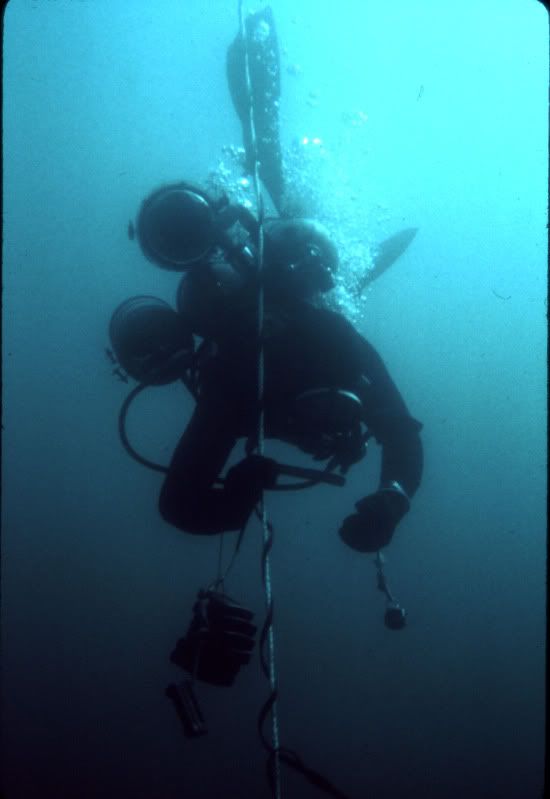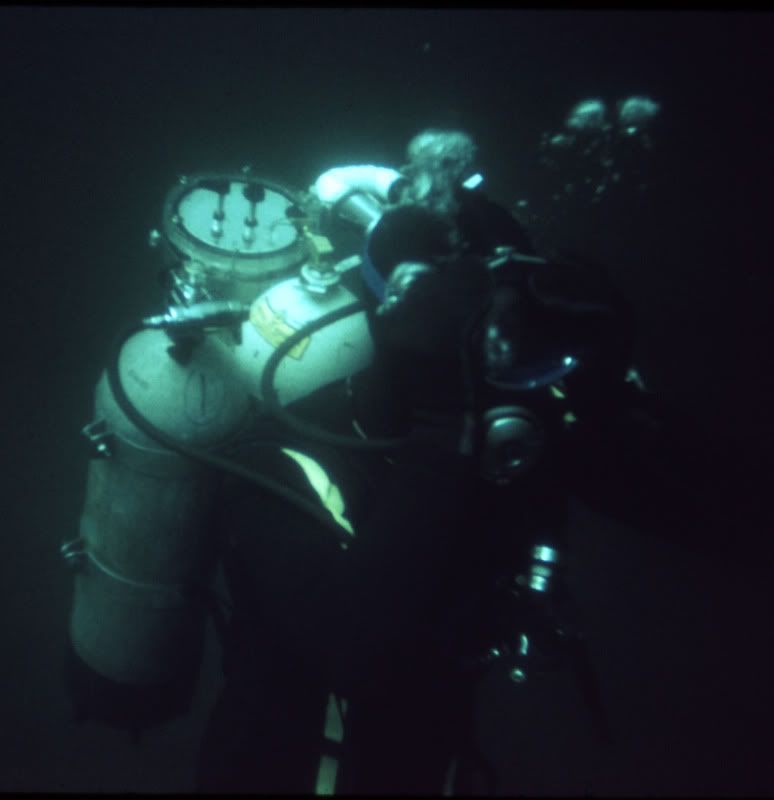Aysha,
I think it was pretty evident that with the type of failure he had, DD had an empty BC. I think he refused to answer because he had made it pretty clear that the BC would not hold air.
To all,
I'm looking at your quote from B.F. Skinner, that "Education is what survives when what has been learned has been forgotten." I think this is a bit of a contradiction, in that if something is actually learned, it is almost never forgotten. But what can happen, and has happened to me, is that in a situation which is perceived as an emergency, attention is focused. Sometimes that focus is inappropriate to the circumstances. NAUI, in its instructor manual, had a section titled
Exertion and Breathing (The Panic Syndrome). I seem to remember it also as the "panic-exhaustion syndrome." Here is what that manual stated:
When one works very hard, the normal reaction is to breathe at a faster and deeper rate. But if the person is apprehensive the breathing may become very fast and shallow. Rapid, shallow breathing does not properly flush the lungs of the increased CO2 load, nor does it bring all the available oxygen down into the lungs.
The best way to recover from heavy exertion is to relax as much as possible and breathe deeply and slowly. Fight the urge to pant or take shallow short breaths. This is particularly important when breathing through divivg equipment, such as a snorkel or scuba regulator.
If you are on the surface and get out of breath, turn over on your back, kick slowly as you inflate your BC. If underwater with scuba gear, relax, slow down, drop any heavy oxjects you are carrying, take longer, slower, deeper breaths and maintain your position while you recover...
In some of my past training, it was pointed out that people who are in the Panic Syndrome focus their attention on one thing. If they are drowning, someone may try to literally climb out of the water until they are too tired to maintain themselves, and sink. However, if they started out the dive about neutrally buoyant without anything in the BC, then attaining positive buoyancy is a simple thing--dropping weights or inflating something. If a float is available, it can be used (indeed, that's what we did before BCs--use inner tubes on the surface).
Let me show you two photos taken of me in an underwater physiology experiment in 1971:
Here, I'm descending to a depth of 73 feet in a fresh water lake (Clear Lake, in the Oregon Cascade Mountains east of Eugene, Oregon). Note that I'm carrying my weights in my hand.
In this photo, I'm getting ready for the work physiology research by switching regulators so that my respirations, O2 consumption, and exhalations can be sampled. I was to swim along a horizontal line for a set number of minutes to determine the effect of cold and depth on work (we did this at 3 feet and 37 feet too, simulating 1, 2 and 3 atmospheres of pressure). But note that I am not wearing any weights--none at all. And I'm neutral in the water.
This is why I did not think DD was in any trouble at all in his situation. He simply had lost the BCs capability of achieving neutral buoyancy. But he was kneeling on a wreck at the time, and could stay there with no further problems. He could push off it to initiate a swim to the surface, and he elected to use a second buoyancy device to help him out. There was no Panic Syndrome, and no complicating factors where he was (although there was some chop on the surface).
In the next paragraphs, NAUI explains a hypothetical accident caused by this Panic Syndrome:
A tired, over-weighted diver fighting to stay on the surface may face disaster. Referred to as "The Panic Syndrome" the scenario develops as follows: The diver has failed to inflate the buoyancy system upon surfacing. The diver is too heavy, yet still does not drop the weight belt. The snorkel is out of the mouth and the more the diver struggles to stay up, themore CO2 the body creates. Increasing fatigue and awareness of danger leads to panic. Panic causes shallow, rapid breathing which is inefficient. Breathing inefficiency further starves the body of oxygen while the diver struggles harder and harder to stay above the surface. Unless this chain is broken, the diver may drown.
By improving breathing efficiency, gaining additional buoyancy with the BC or by dropping the weight belt, the chain of events may be broken. Such surface accidents are definitely preventable. All divers should be properly trained in how to rest and relax inthe water. They should also be able to recognize when they are getting into difficulty and know what steps to take to break the chain of events leading to The Panic Syndrome.
NAUI The Pro Manual, II-39, 1977
One more piece of information which can contribute to The Panic Syndrome--the diver's regulator. I collect old, vintage diving regulators. I tear them apart, dive them, and improve them. A diver needs to know that his regulator is working as well as it can work. (S)He also needs no know whether it is a good-performing regulator. I recently got a 1950s version of the
Dacor Dial-A-Breath regulator to tear apart. I had owned their later R-4 regulator, and was not impressed with it. The earlier version performed in the pool pretty well, as well as their later version. But this was a pool test. When I looked up the
US Navy tests, I found that this regulator did not pass because of high exhaust effort, and poor performance at depth under high work load. The Navy recommended to Dacor that they look at the interstage pressure, opening size, etc. before re-submitting this type of regulator. I now have the US Navy Tests on the
Dacor R-4, and the
Dacor C3NB, and none of these two-hose regulators passed the U.S. Navy Experimental Dive Team tests. Dacor did not vastly improve these regulators over the years (their Pacer regulators did pass these tests though).
I dove a similarly poor-performing regulator in the same lake mentioned above, and it was bad enough I had to swim underwater on my back to get the air I needed out of it (US Divers Aqualung, their original unit, which also was tuned badly).
I remember investigating a fatal accident many years ago which involved what should have been a high-performing regulator. When I tested that regulator, the suction effort was over 10 inches of water pressure (measured on my home-made manometer). This regulator should have been measuring less than 1.5 inches of water pressure suction effort. This was a primary contributing factor to this fatality--the poor maintenance of the regulator, but not the only one (overweighted, very poor fitness for diving, ran out of air too). All these factors came together to cause this fatality.
But I saw none of this in DD's incident.
TS&M,
I have a spot in my dive log that is titled "Special Problems and Proposed Solutions." I have very few dives where there is no entry here. These are the little things that go wrong, and by tracking them, I can see trends. For instance, years ago I kept putting into this area that I was getting cold. I'd say it in many different ways, but when I went back and looked over a period of time, I found that I really needed a dry suit. Another instance, I stated that my "Avanti fins worked very well in the current, but are still very difficult to get off. They are also hard to hold out of water w/ their elongated foot pocket." This was in March of 1986. In April of 1986, I made the following observation in this section, "The Avanti fins are very difficult to get off. I had to take my gloves off to get them off." Water temperature was 46 degrees F. I ended up cutting away much of the elongated foot pocket. But if I had not started tracking this, I would not have figured out that these fins had that as a design problem.
SeaRat
PS--If you want copies of those tests, follow the link and go to the bottom right side of the page to download the actual tests. If you want other tests, type "regulator" into the Rubicon search engine.





